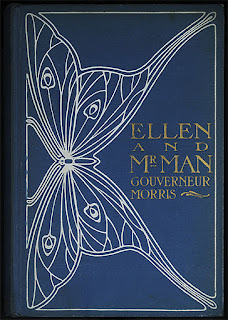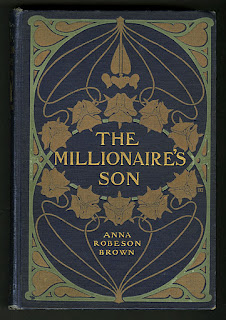 |
Until the 19th century, books were sold unbound or sewn into simple paper covers. A collector of books would commission the local bookbinder to come up with a binding for all the books of his library. By about the 1860s, soon after the American Civil War, cloth bindings became popular and began to feature gilt stamps, blind embossing and flamboyant custom designs. As binding technology advanced, so entered the Arts and Crafts, Art Nouveau and Art Deco movements creating an artistic confluence that produced extraordinarily beautiful book covers in a short space of time. Then came paper dust-jackets which, alongside a change in public taste, caused the decline of these decorative cloth bindings. That was the end of that.
"Most significant in the last decade of the [Nineteenth] century, particularly in America, is the rise of the artist-designer. From the late 1880s until about the start of World War I, book covers reached new levels of sophistication through highly professional layouts and stylized pictorial representations.
"Architects, landscape painters, illustrators and graphic artists alike were drawn to book design. While some of these designers would be responsible for only a handful of covers, others were extremely prolific, producing hundreds and hundreds of covers. Consequently, decorated cases of this period display an astonishing diversity of design styles and reflect a wide range of influences, including the Arts and Crafts movement, Art Nouveau, Japanese prints and the so-called poster style of design." (source)
In stepped the Decorative Designers (or DD as the company was called), in 1895. It was founded by the husband and wife team of Henry and Lee Thayer, a talented and incredibly driven team of artist-designers with a real head for business. "The founder of the firm was Henry Thayer (1867–1940) who was trained as an architect (following the example of Stanford White, architect-book cover designer). Thayer was responsible for much of the lettering produced by the firm." Henry was the business guy, and did a lot of the lettering, but Emma Redington Lee (1874–1973) as she was actually named, was the real star in my opinion.
She started out as a mural artist, but upon co-founding DD with Henry, became a serious figure in publishing and design. Lee Thayer (as she was known) specialized in decoration, and designed most of the bindings including the beautiful decorative borders and designs, and also published over sixty mystery novels as well as many Children's books. She was responsible for designing a staggering amount of titles in a relatively short space of time. Anything up to 20,000 by some estimates. "During the heyday of decorated publishers' bindings no other American designer produced as many book covers as The Decorative Designers." (source)
The Decorative Designers monogram appeared on over 25,000 book covers, dust jackets, and text decorations. Still thirsty for more examples? I posted over one hundred here.
Henry Thayer and Emma Redington Lee Thayer were married in 1909 but later divorced in 1932, on the grounds of desertion. Who deserted whom, I don't know. I can guess, but I'd like to think Lee jumped into a 1920 Revere Tourer and sped off with her tennis instructor Rupert, silk scarf flying.
"Other graphic designers as talented and prolific as the Thayers worked for the company at various times, the most important being Jay Chambers, who was with The Decorative Designers from 1902 through 1916. The firm produced thousands of book covers at a rapid rate. The number of artists in the organization partly accounted for this. Another factor in the success of the “DD's” was its efficient and innovative method of operation. Labor was divided according to individual talents: Henry Thayer did lettering and handled business affairs, Lee Thayer specialized in conventionalized decorations, Jay Chambers excelled at figure design, and so on." (source)
Their designs were often initially sketched by hand, then transferred to brass plates and engraved by Rome K. Richardson and Adam Empie, both of whom occasionally designed covers individually using the monograms RR and a conjoined AE, respectively. Charles Buckles Falls (d.1960) and Jay Chambers (d. 1929) were in charge of drawing the figures featured in narrative designs. (source)
"After 1900, cover designs gradually became simpler. By 1910, the widespread use of decorated cloth on books was largely at an end. The illustrated paper book jacket, which had been in limited use for years, caught the public's fancy and proved to be an even cheaper advertising tool than decorated cloth cases. The golden age of publishers' bookbindings was over." (source)
It was a short but illustrious run.
 |
| One of my faves, with no less than Maxfield Parrish illustrating |
 |
| The distinctive double D logo that appeared on their designs |













































books. books. is there a support group for this kind of collecting?
ReplyDeleteBeautiful! ...
ReplyDeleteLucky Rupert!
I had to wipe the drool off my screen when saw the Italian Villas book! I was a librarian for 12 years (in another life time) in a small private library. All kinds of books would be donated by patrons over the years. The covers I saw sometimes made me almost weep! This is a wonderful post but makes me even more sad as the Kindle and Nook bring the demise to publishing almost altogether.I think only reference books and children's will survive in the future.. there is still nothing like physically holding a book and opening it up for the first time and smelling all that paper and ink!!!
ReplyDeleteOh my, these are beautiful!
ReplyDeleteOh, and I'd like to remind you that the Booksniffers Anonymous meeting's on Friday.
ReplyDeleteWonderful covers--some of my DD favorites are here!
ReplyDeleteYou might also enjoy www.amysacker.net
where the works of a DD contemporary can be seen.
Those are stunningly beautiful. Thank you for this blog post!
ReplyDeleteHave you moved your collection of images from Flickr to another platform?
ReplyDelete